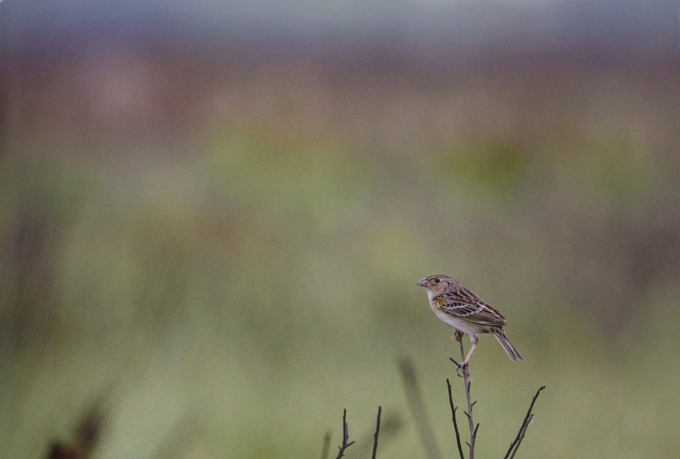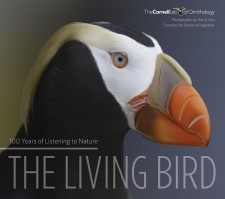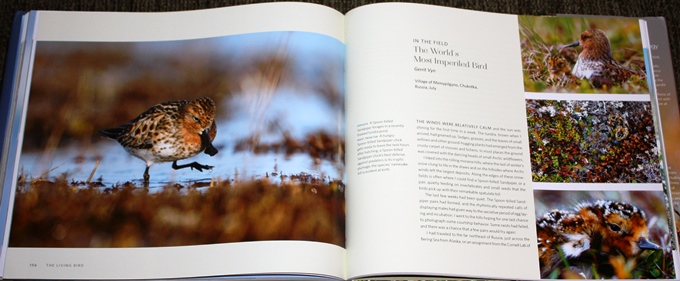Reviewed by Grant McCreary on November 4th, 2015.
Anyone who has been interested in birds for long will likely be aware of the Cornell Lab of Ornithology. The research carried out and innovations created there have greatly benefited birds. And birders, too. eBird anyone? 2015 marks the Lab’s 100th anniversary. They would have been completely justified in publishing a book celebrating their many accomplishments over the last century. Instead, they have given us “an ode to birds, a celebration of everything we love about them” in The Living Bird: 100 Years of Listening to Nature.
Three essays, from three different authors, expound the wonders of birds, how they inspire us, and how they have served as bellwethers of environmental issues. But the first thing you will notice about this book is the photographs, all by Gerrit Vyn. The contributor biography pages in the back of the book are devoid of photos, and a couple pages “only” show some birders. Why mention this? Because every other two-page-spread in the entire book has at least one gorgeous bird photograph. Every. Single. One. And not just pretty, mind you, but knock-your-socks-off, calendar-worthy images. The book’s size and landscape orientation allows many of the images to be shown large on the page, giving them even more impact.
The subjects are all birds of the United States and Canada, with two exceptions: American Flamingos at a colony in Mexico, and Spoon-billed Sandpipers. A nice diversity of birds are included, from ducks to owls to warblers. I appreciate that not just flashy birds have a place in this book. In fact, among the best photos here is one of North America’s drabbest birds – a Grasshopper Sparrow. I must admit I was pretty surprised by that. After all, it’s a small, brown bird that is fairly small in the frame. Yes, it’s technically flawless, at least to these inexpert eyes. But then, all of the images here are. This particular bird is of the Florida subspecies which, according to the caption, is “the most endangered bird in the mainland United States,” which does make it more impressive. It may just be me, but the shot is unexpectedly evocative. The composition, with the bird small and off-center, and shallow depth of focus, with the background a colorful blur, make it easy to believe this bird could be one of the last of its kind.

Or maybe I’m just reading too much into it. Regardless, Vyn’s photographs are amazing, and reason enough to get this book. But they aren’t the only reason – three main essays and several smaller sections are all well worth reading.
The first of the essays, by noted bird researcher and author Scott Weidensaul, provides a “survey of the amazing diversity of birds and what they can do.” It looks at the many wonders of birds, including their dazzling array of colors, power of flight, sweet songs, and mind-boggling migrations. Less obvious, but no less amazing, characteristics – such as molt and intelligence – are also covered. This chapter makes an excellent primer for anyone wondering what’s so special about birds. Well-read birders, however, won’t find much new here, as many other books cover the same ground (The Thing with Feathers, for one).
Next, author and “eco-philosopher” Lyanda Lynn Haupt revels in the “wonder and inspiration in attuning to the lives of birds.” It’s a meandering piece, moving from bird songs to observation gathering and reporting (eBird, Christmas Bird Counts, and the like) to the threat of climate change. But inescapable throughout is the joy of “the simple presence of the birds in our midst,” which in turn makes this essay a joy to read.
In the final essay, John Fitzpatrick, the director of the Lab, shows how “birds serve as our most accessible gauges for measuring habitat condition and as beacons of environmental problems that demand our attention.” The most well-known example is the population crash of Bald Eagles, Peregrine Falcons, and other raptors due to the pesticide DDT that “sounded an alarm pertinent not just to wildlife but also to human health.” Many other, less-well-known cases are cited, such as a population increase in Henslow’s Sparrows, showing that the Conservation Reserve Program, in which farmers commit to letting some tracts go fallow for a time, is a worthwhile effort. These lessons show that, as Fitzpatrick writes, “We must recognize that declining bird populations are warning signals about the quality of our landscapes and ultimately the quality of our lives.”
Interspersed throughout the book are shorter sections – photo galleries, travelogues by the photographer, and people profiles. The galleries, of owls, Sandhill Cranes, birds of the sagebrush, and others, are spectacular. Likewise, Vyn’s “In the Field” reports, detailing his adventures photographing a flamingo colony, seabirds in Alaska, and Spoon-billed Sandpipers, are fun to both read and, thanks again to his marvelous photography, look at.
The profiles – of an audio recordist, citizen scientist, and researcher – seem out of place, at least at first. Each two-page profile is interesting, but doesn’t really fit the theme of celebrating birds. They do, however, serve to highlight three of the Cornell Lab of Ornithology’s greatest contributions: the Macaulay Library of natural sounds, eBird, and the research carried on by its students. This, along with a short history and description of the Lab in the back of the book, provide a quick introduction to the Lab and its work. I guess that’s only fair, considering this book celebrates their anniversary, after all!
Finally, we get to the opening and closing of the book. In the introduction, acclaimed novelist Barbara Kingsolver describes how she became interested in birds. Or, rather, how she couldn’t escape them. It provides the perfect opening for a book celebrating birds. As the book progresses, though, there is a subtle shift, culminating in Jared Diamond’s afterword looking ahead to The Coming Decades. It is here that The Living Bird becomes “a plea for action, a call to arms” to halt the decline in many bird populations. After reading these inspirational stories and seeing these glorious photographs, who wouldn’t want to do that? To that end, the book gives a short list of actions, things that anyone can do, to help.
Recommendation
The Living Bird: 100 Years of Listening to Nature presents, through words and images, a simple message: Birds are amazing…They enrich our lives…We need them…They are in trouble…Here’s what you can do. This book is worth buying for the pictures alone – the work of Gerrit Vyn is stunning. But if you take time to read it, you’ll be even more amazed at his subjects. And, hopefully, inspired to help them.
Disclosure: I get a small commission for purchases made through links in this post.
Buy from NHBS
(based in the U.K.)
Disclosure: The item reviewed here was a complementary review copy provided by the publisher. But the opinion expressed here is my own, it has not been influenced in any way.







Comment